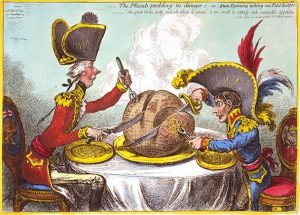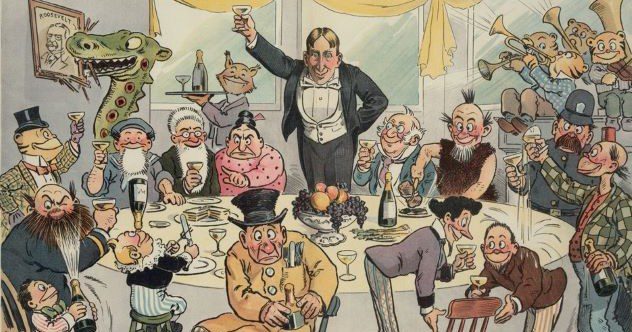From “Family Circle” to “Garfield,” cartoons have always combined subtle sarcasm with over-the-top caricatures. But nothing quite captures our attention like political cartoons. They’re a form of silent and artistic protest, saying with a few panels what most of the world is afraid to put into words. Here are ten cartoons with powerful messages that have impacted readers around the world.
Related: Ten Vicious & Violent Political Feuds from American History
10 “The Plumb-Pudding in Danger” by James Gillray

The political cartoon “The Plumb-Pudding in Danger,” crafted by the renowned caricaturist James Gillray, stands as a potent and enduring commentary on the complex dynamics of early 19th-century European geopolitics. Created in 1805 during the Napoleonic Wars, the cartoon captures the delicate balance of power and the ambivalence of alliances.
Depicting British Prime Minister William Pitt the Younger and French Emperor Napoleon Bonaparte seated across a table, the image uses culinary metaphors. Pitt, symbolizing Great Britain, carves into a vast globe-shaped plum pudding that signifies the world. Napoleon, representing France, eagerly reaches across the table with a knife and fork, mirroring the territorial ambitions of his empire.
The visual satire masterfully encapsulates the dual nature of the Anglo-French relationship during that era. Pitt and Napoleon’s jovial demeanor conceals their strategic calculations and underlying tensions. The shared table is both a symbol of collaboration and an allegory for the potential dissolution of nations. Gillray’s meticulous detailing, from the costumes to the facial expressions, conveys the subtleties of international diplomacy.
9 “Why So Angry” by Rob Rogers
Rob Rogers, an accomplished and nationally syndicated editorial cartoonist, masterfully captures the persistent struggles faced by the Black community in his poignant cartoon titled “Why So Angry.” Through his artwork, Rogers sheds light on the mistreatment of Black people by the “law” over time and the frustration that has led to ongoing protests and activism.
Rogers depicts the continuous cycle of injustice, where the mistreatment of Black people remains distressingly consistent. The cartoon confronts the prevailing issue of systemic racism by highlighting how little has truly changed over time despite societal progress and supposed advancements in civil rights.
In the cartoon, Rogers deliberately portrays the palpable anger within the Black community. He uses shades of blue to envelop most of the imagery, symbolizing the sadness and frustration that have been constants in their lives. The unrelenting cycle of mistreatment is illustrated through scenes depicting familiar instances of historical and contemporary injustice.
The final image breaks free from the blue hue and is rendered in full color. This image portrays a white man wearing a red hat, an allusion to the Republican Party’s symbol, who wonders aloud why Black people are so angry and engaged in protests. This poignant scene embodies the inability or unwillingness of certain segments of society, often those in positions of privilege, to recognize the deep-rooted injustices that continue to fuel the anger and frustration of the Black community.
8 “Join, or Die” by Benjamin Franklin
“Join, or Die,” a political cartoon created by Benjamin Franklin in 1754, stands as a potent symbol of unity and collective strength. As one of the earliest forms of political satire in America, the cartoon conveys a message transcending its historical context. The image features a segmented snake, each segment representing a British American colony, along with the imperative slogan, “Join, or Die.”
Franklin’s cartoon aimed to rally support for colonial unity during the French and Indian War, urging the colonies to set aside their differences and unite against a common enemy by fighting with the British against the French. The disjointed snake depicted the vulnerability of colonies in the face of a formidable adversary, while the call to “Join, or Die” underscored the urgent need for collaboration.
Beyond its immediate impact, “Join, or Die” has endured as a powerful emblem of solidarity. It has been adopted throughout American history to address issues that demand action. The meaning changed after 1765 with increased British taxation, becoming a rallying cry for the American Revolution. It was also adopted by those advocating for the ratification of the U.S. Constitution. As such, the cartoon’s message emphasizes the importance of cohesive efforts to overcome challenges.
It serves as a reminder that when individuals join forces, they can achieve far more than when divided.
7 “We Can Do It!” by J. Howard Miller
“We Can Do It!” is a renowned political cartoon by J. Howard Miller. It represents the spirit of empowerment during World War II and features Rosie the Riveter, an iconic representation of women in the workforce. She symbolized female resilience and capability in times of national crisis.
The cartoon was originally created in 1943 by Miller as part of a series of posters aimed at boosting morale and encouraging women to join the war effort by taking on industrial jobs traditionally held by men. With her rolled-up sleeves, flexed arm, and the bold slogan “We Can Do It!” displayed above her, Rosie exudes confidence and strength. It challenges traditional gender roles and emphasizes women’s vital role in supporting the war.
The cartoon is still used today, serving as a symbol for everything from advocating for equal pay and rights in the workplace to inspiring women across generations to pursue their ambitions.
6 “The Choice” by Ann Telnaes
Ann Telnaes, a trailblazing editorial cartoonist, ingeniously captured the essence of the contentious 2000 presidential election through her satirical masterpiece titled “The Choice.” This artwork humorously portrays the competing candidates, Al Gore and George W. Bush. Telnaes’s unique approach to visualizing the candidates as cereal choices provides a vivid and memorable representation of the contrasting personalities.
In a stroke of satirical brilliance, Telnaes casts Al Gore as a box of bran cereal and George W. Bush as a box of frosted flakes.
And you can’t miss the clever details on the cereal boxes. Gore’s box is described as deeply “artificial,” hinting at his perception as lacking authenticity. On the other hand, Bush’s box is playfully labeled with terms like “sugary” and “nutz,” capturing his campaign’s charismatic and often polarizing nature.
A particularly interesting element of the cartoon is the inclusion of three additional candidates in a “variety pack cereal” off to the side. This detail subtly underscores the limited choices available to voters, highlighting the dominance of the two-party system in American politics.
5 “My Body My Choice” by Harry Burton
Harry Burton, an award-winning political cartoonist hailing from Dublin, Ireland, shares his commentary on autonomy and power dynamics in his cartoon titled “My Body My Choice,” which originally appeared in the Irish Examiner. Drawing inspiration from Grant Wood’s iconic painting American Gothic, Burton reinterprets the scene to address contemporary issues surrounding bodily autonomy and individual rights.
In “My Body My Choice,” Burton preserves the recognizable figures of a farmer and his wife while adding a distinct twist. There’s an upside-down American flag on the roof—a powerful symbol of distress.
The wife says, “My body,” echoing the rallying cry for women’s bodily autonomy and the right to make decisions about their own bodies. The husband retorts, “My choice,” while dressed as a Supreme Court judge with a gavel in his hand. Burton highlights the systemic structures that hold authority over personal freedoms.
4 “Fistbump: The Politics of Fear” by Barry Blitt
“Fistbump: The Politics of Fear” is a thought-provoking political cartoon by Barry Blitt that graced the cover of the New Yorker in 2008. This iconic artwork skillfully comments on the political landscape of that year and the 2008 U.S. Presidential Election.
In the cartoon, two figures exchange a fist bump in the Oval Office. However, it hits home that it’s Barack Obama and his wife Michelle. This sign of camaraderie and unity is played against the backdrop of fear-mongering tactics often employed in political campaigns. It shows a tension between Obama’s message of hope and unity and the fear-based strategies that some believe were used to undermine his campaign.
Blitt’s work masterfully distills complex political concepts into a single image. The White House setting and the subdued color palette suggest a clandestine atmosphere, alluding to the notion that Obama’s message of unity stood in contrast to the divisive political climate. During the 2012 campaign, people said many things about the Obamas, some not so nice or true—specifically that Barack was a Muslim and Michelle was some sort of Black Panther radical. Blitt added some details to the cartoon that added to the controversy—the Bin Laden portrait and the burning U.S. flag.
3 “Migrant Child Facility” by Lalo Alcaraz
In “Migrant Child Facility,” Lalo Alcaraz adeptly presents a side-by-side juxtaposition of the treatment of migrant children under the presidencies of both Donald Trump and Joe Biden.
Alcaraz is a distinguished and nationally syndicated editorial cartoonist who uses visual storytelling to shed light on immigration policies in his cartoon “Migrant Child Facility.” The stark contrast between the two panels speaks volumes about the political manipulation of language to shape public perception.
Under Trump’s presidency, the cartoon illustrates a child confined within a cage labeled “Kids in cages.” It shows the harsh reality of the treatment of migrant children during that time, highlighting the inhumane conditions they were subjected to. The imagery itself is a powerful commentary on the dehumanizing impact of these policies.
But the cartoon shows that, under Biden, the same child is in the same cage, but this time, the label reads “Migrant child facility.” The child’s situation remains unchanged, yet the label shift attempts to soften the perception of the situation. It critiques the political tendency to repackage existing issues under more palatable names without addressing the core problems.
2 “Trump Sycophants” by Michael Ramirez
In his cartoon “Trump Sycophants,” Michael Ramirez aptly captures the nuances of loyalty, leadership, and the ethics political figures face. Ramirez is an acclaimed editorial cartoonist and recipient of prestigious awards, including the Pulitzer Prize. He uses his artistic platform to delve into the realm of political satire.
“Trump Sycophants” centers around Uncle Sam manning a coat check station at a GOP debate. The sign at the coat check station reads “Hat, coat, and spine check,” immediately setting the tone. Ramirez ingeniously uses a clown hat included among the checked hats to symbolize the spectacle you see when politicians prioritize loyalty over sound decision-making.
The most striking element in the cartoon is a row of human spines hanging next to the coats. This powerfully conveys the idea that some candidates have left their moral backbone at the door in exchange for loyalty to a nominee, regardless of their qualifications or ethical concerns.
Accompanying the cartoon is the text, “By pledging to support a convicted nominee, six out of the eight Republican presidential candidates fail the test of leadership.” This text contextualizes the imagery by highlighting the moral dilemma political figures face when they prioritize loyalty to a party figure over their responsibility to uphold principles of leadership and integrity.
1 “The Bosses of the Senate” by Joseph Keppler
“The Bosses of the Senate” is a renowned political cartoon created by Joseph Keppler in the late 19th century. Crafted during a time of immense political corruption and corporate influence in American politics, the cartoon was published in Puck magazine in 1889. It’s a scathing commentary on businessmen’s control over the U.S. Senate, raising concerns about the erosion of democracy.
The cartoon depicts a grotesque octopus with its tentacles wrapped around the Senate chamber, portraying large corporations and trusts as the tentacles strangling the legislative process. Each tentacle represents a specific industry, highlighting their undue influence over lawmakers.
The octopus’s menacing presence symbolizes the suffocating grasp of corporate power on the democratic institutions meant to serve the people. “The Bosses of the Senate” encapsulates the public’s fear and frustration over the government’s lack of accountability and transparency.
The cartoon served as a call to action, sparking conversations about campaign finance reform and the need to curb the undue influence of moneyed interests in politics.
